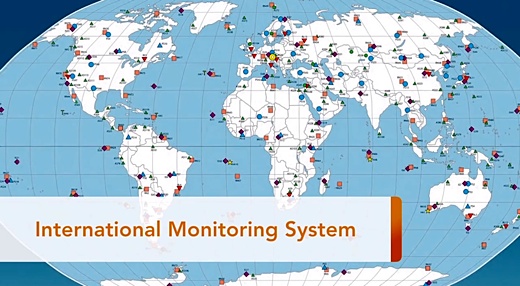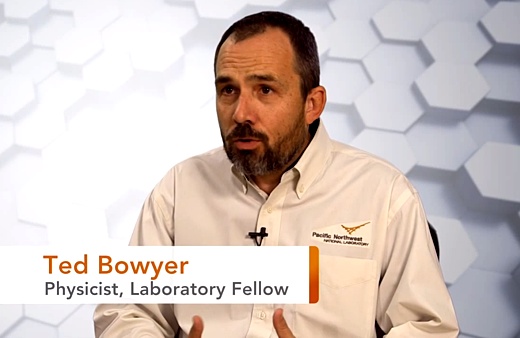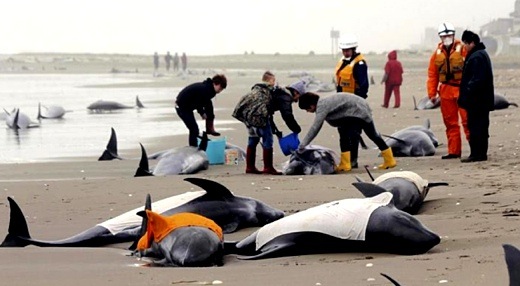SUBHEAD: How bad is the Pacific Ocean from Fukushima radiation? What they did not tell you.
What the monitors show
By Admin on 9 April 2015 for ENE News -
(http://enenews.com/govt-experts-astounding-radiation-levels-measured-fukushima-almost-500000-times-normal-weve-never-anything-close-amazing-7000-km-away-matter-life-death-videos)

Image above: Still from profile by Ted Bowyer of the Pacific Northwest Laboratory showing international radiation monitoring stations of the Comprehensive Nuclear Test Ban Treaty Organization used by the Pacific Northwest Laboratory to determine impact of Fukushima radiation. . From (https://youtu.be/zON3mzhT9ao).
[IB Publisher's note: Some solid information about the impact of Fukushima seems to have disappeared. On one hand a video by Harry Miley (a senior scientist of the Pacific Northwest Laboratory, PNNL) glossing over the dangers of health risks from Fukushima radiation is easily found on the internet (https://youtu.be/iytg9CsWAn4). Another video by a colleague of Harry Miley’s at PNNL seems to have dissappeared. Ted Bowyer, a laboratory fellow at the PNNL discussed radioactive air samples from Fukushima taken in North America in a video taken at a meeting of the commission for the Comprehensive Nuclear Test Ban Treaty Organization (CTBTO). That video seems to have disappeared, or a mis-direction in its link has obscured it. Ted Bowyer, discussed the radioactive air samples at a CTBTO meeting: This link EneNews used no longer links to Ted Bower's presentation (http://video-archive.ctbto.org/p/100/sp/10000/serveFlavor/flavorId/0_u1s0q1ch/0_ktplaceq.mp4). However a "slide" presentation by Ted Bowers of measured radioactive Xenon PNNL monitored after Fukushima meltdowns is here (http://www.ctbto.org/fileadmin/user_upload/SandT_2011/presentations/JS-O7%20T_Bowyer%20Detection%20of%20Elevated%20Xe-133%20following%20Fukushima.pdf)]

Image above: Still from Pacific Northwest Laboratory video showing Ted Bowyer making presentation. From (https://youtu.be/zON3mzhT9ao).
What the monitors show
By Admin on 9 April 2015 for ENE News -
(http://enenews.com/govt-experts-astounding-radiation-levels-measured-fukushima-almost-500000-times-normal-weve-never-anything-close-amazing-7000-km-away-matter-life-death-videos)

Image above: Still from profile by Ted Bowyer of the Pacific Northwest Laboratory showing international radiation monitoring stations of the Comprehensive Nuclear Test Ban Treaty Organization used by the Pacific Northwest Laboratory to determine impact of Fukushima radiation. . From (https://youtu.be/zON3mzhT9ao).
[IB Publisher's note: Some solid information about the impact of Fukushima seems to have disappeared. On one hand a video by Harry Miley (a senior scientist of the Pacific Northwest Laboratory, PNNL) glossing over the dangers of health risks from Fukushima radiation is easily found on the internet (https://youtu.be/iytg9CsWAn4). Another video by a colleague of Harry Miley’s at PNNL seems to have dissappeared. Ted Bowyer, a laboratory fellow at the PNNL discussed radioactive air samples from Fukushima taken in North America in a video taken at a meeting of the commission for the Comprehensive Nuclear Test Ban Treaty Organization (CTBTO). That video seems to have disappeared, or a mis-direction in its link has obscured it. Ted Bowyer, discussed the radioactive air samples at a CTBTO meeting: This link EneNews used no longer links to Ted Bower's presentation (http://video-archive.ctbto.org/p/100/sp/10000/serveFlavor/flavorId/0_u1s0q1ch/0_ktplaceq.mp4). However a "slide" presentation by Ted Bowers of measured radioactive Xenon PNNL monitored after Fukushima meltdowns is here (http://www.ctbto.org/fileadmin/user_upload/SandT_2011/presentations/JS-O7%20T_Bowyer%20Detection%20of%20Elevated%20Xe-133%20following%20Fukushima.pdf)]

Image above: Still from Pacific Northwest Laboratory video showing Ted Bowyer making presentation. From (https://youtu.be/zON3mzhT9ao).
ENENews outtakes from "disappeared" CTBTO video of Ted Boyer presentation:
- 0:30 sec in – “I agree with everything that previous speakers said, especially the aspect that more work is necessary… We have a lot of work to do… We have a lot of questions that we need to answer. There are a lot of people working on it. I also really thought it was very valuable to have this email exchange with… interested parties about events as they were unfolding in Japan. The accident as everyone knows was a terrible tragedy.”
- 3:30 min in – Slide: Evidence of radionuclide release reached the Japanese IMS station within 2-3 days; First evidence of the plume hitting the U.S. came to PNNL’s equipment about 1 day later
- 4:30 min in – “This is very amazing to me, having been working in the radioactive xenon monitoring field for about 17 years now. This was astounding to me… You can see background levels around 0.1 mBq/m3… Note the peak concentration we saw was in the range of 45,000 mBq/m3 — so that is 450,000 times our background level. For me that’s astounding. We never have ever seen anything even close to that. So the concentrations went up and up and up every day, and so that was quite amazing to see this 7,000 kilometers away from the event… I only show some of the data here, but it actually persisted for weeks at very measurable levels, and filled the entire northern hemisphere and mixed into the southern hemisphere.”
- 12:00 min in – “Xenon isotopic ratios appear to generally agree with calculations. However, there’s some uncertainty… We have a lot of work to do to try to understand whether there are calibration issues, whether there were physics here that we had not accounted for, etc. We do know that there are very high count rates at these detectors, which is similar to what you’d expect in an atmospheric detonation. On the other hand, the part I didn’t tell you was the amount of xenon we saw was consistent with a one megaton atmospheric detonation — we obviously wouldn’t expect to see that high. But it was a huge amount.”
SUBHEAD: A broad detailed review of documents from TEPCO and others indicating extent of releases of radioactive elements into environment.
What the documents show
By Patrick Henrey on 3 January 2105 for YouTube -
(https://www.youtube.com/watch?v=klgUBofqyok)
Video above: A 44 minute video detail studies on radiation in the Pacific Ocean related to Fukushima Nuclear Power Plant meltdowns. From (https://youtu.be/klgUBofqyok).
[IB Publisher's note: This is a dry and extensive review of reports indicating the extent of radioactive fallout in the Pacific Ocean after the meltdowns of three nuclear reactors at Fukushima Daiichi in 2011. If you want the facts many are here.]
Cesium, iodine and tritium in NW Pacific waters -- a comparison of the Fukushima impact with global fallout
http://tinyurl.com/bnfwcnr
http://www.biogeosciences-discuss.net...
Impacts of the Fukushima nuclear power plant discharges on the ocean
(MULTIPLE studies found here)
http://www.biogeosciences-discuss.net...
http://tinyurl.com/k925vhs
THE 20 STUDIES IN LINK ABOVE INCLUDE:
1~ Inverse estimation of source parameters of oceanic radioactivity dispersion models associated with the Fukushima accident
2~ Surface pathway of radioactive plume of TEPCO Fukushima NPP1 released 134Cs and 137Cs
3~ Determination of plutonium isotopes in marine sediments off the Fukushima coast following the Fukushima Dai-ichi Nuclear Power Plant accident
4~ Iodine-129 concentration in seawater near Fukushima before and after the accident at the Fukushima Daiichi Nuclear Power Plant
5~ Short-term dispersal of Fukushima-derived radionuclides off Japan: modeling efforts and model-data intercomparison
6~ Initial Spread of 137Cs over the shelf of Japan: a study using the high-resolution global-coastal nesting ocean model
7~ Direct observation of 134Cs and 137Cs in surface seawater in the western and central North Pacific after the Fukushima Dai-ichi nuclear power plant accident
8~ 90Sr and 89Sr in seawater off Japan as a consequence of the Fukushima Dai-ichi nuclear accident
9~ Fukushima-derived radiocesium in western North Pacific sediment traps
10~ Natural and Fukushima-derived radioactivity in macroalgae and mussels along the Japanese shoreline
11~ Export of 134Cs and 137Cs in the Fukushima river systems at heavy rains by Typhoon Roke in September 2011
12~ Continuing 137Cs release to the sea from the Fukushima Dai-ichi Nuclear Power Plant through 2012
13~ The impact of oceanic circulation and phase transfer on the dispersion of radionuclides released from the Fukushima Dai-ichi Nuclear Power Plant
14~ Does the Fukushima NPP disaster affect the caesium activity of North Atlantic Ocean fish?
15~ Spatiotemporal distributions of Fukushima-derived radionuclides in surface sediments in the waters off Miyagi, Fukushima, and Ibaraki Prefectures, Japan
16~ Distribution of the Fukushima-derived radionuclides in seawater in the Pacific off the coast of Miyagi, Fukushima, and Ibaraki Prefectures, Japan
17~ Cesium-134 and 137 activities in the central North Pacific Ocean after the Fukushima Dai-ichi nuclear power plant accident
18~ Horizontal distribution of Fukushima-derived radiocesium in zooplankton in the northwestern Pacific Ocean
19~ One-year, regional-scale simulation of 137Cs radioactivity in the ocean following the Fukushima Daiichi Nuclear Power Plant accident
20~ Cesium, iodine and tritium in NW Pacific waters -- a comparison of the Fukushima impact with global fallout.
WSJ: Soaring radioactivity levels on coast of Fukushima plant — Nuclear material may have leeched from melted fuel cores and into environment:
http://tinyurl.com/n8vj52o
Wall Street Journal, July 8, 2013: Fukushima Watch: Tritium Levels Soar on Coast at Fukushima Plant [...] More than two years after the devastating accident at Japan's Fukushima Daiichi nuclear plant, operator [Tepco] is seeing levels soar of a radioactive element called tritium. The problem spot is on the coastal side of the plant's heavily damaged No. 2 reactor, one of the areas where Tepco regularly monitors groundwater to check for radioactive elements that may have leeched from the plant's partly melted fuel cores and into the environment. [...]
http://tinyurl.com/lrb26kp
Jiji Press, July 8, 2013: Tokyo Electric Power Co. says 2,300 becquerels per liter of tritium was found in seawater sampled off its crippled Fukushima No. 1 nuclear power station Wednesday, the highest level recorded since the March 2011 accident. [...] It is feared that groundwater containing high levels of tritium may be leaking into the sea from the plant's No. 2 reactor building.
http://tinyurl.com/knwwmzt
Officials report "troubling discovery" at Fukushima nuclear plant: Cesium levels rocket 9,000% over 3 days in groundwater — TEPCO "can't explain it"
http://tinyurl.com/lb2uxks
NHK World
http://tinyurl.com/lb2uxks
Asahi Shimbun:
http://tinyurl.com/khzxcuf
AFP: Toxic radioactive substances in groundwater at Japan's crippled Fukushima nuclear plan have rocketed over the past three days,
http://tinyurl.com/kvp9naqt
Wall Street Journal: Cesium tends to bind with dirt, so it's less likely it would seep distances along with groundwater. [...]
http://tinyurl.com/kh5wqdv
Uncovering Plume-Gate: http://plumegate.wordpress.com/
hatrickpenryunbound: http://hatrickpenryunbound.com/
IMPORTANT:
Plume-Gate PROOF Cover-up of Fukushima via the NRC Documents Playlist (35 videos 26 hours)
http://tinyurl.com/luvc5dx
original upload here: (thank you HatrickPenry) Good Job!
http://youtu.be/P9SilFcYVg4
SUBHEAD: The the multiple "unconnected" mass die-offs in the Pacific Ocean are troubling. Climate Change, Ocean Acidification, Garbage Gyres and Fukushima Radiation may all be contributing.
The "unrelated" die-offs go on
By Admin on 10 April 2015 for ENE News -
(http://enenews.com/wildlife-official-bizarre-multiple-aborted-fetuses-every-day-marine-mammals-san-francisco-many-seal-pups-falling-deaths-when-mothers-led-cliff-edge-pretty-brutal-watch-hundreds-thousands-seabird)

Image above: Volunteers raced to save dozens of helpless dolphins stranded 4/10/15 on the shores of a city located 50 miles from Fukushima. From (http://www.hngn.com/articles/83988/20150410/japan-150-dolphins-stranded-beach-north-tokyo.htm).
KQED Science, Apr 5, 2015 (emphasis added): About thirty miles out from the Golden Gate, the federally protected Farallones are breeding grounds visited by hundreds of thousands of seabirds – many of which use the islands as a winter way station — but not this year. Gerry McChesney, manager of the site for the U.S. Fish and Wildlife Service, says that’s a bad sign not just for the Farallon Islands but also for wildlife more broadly along California’s coast. There was also hardship for breeding marine mammals.
Dozens of pregnant sea lions proved too weak to carry their pups to term “That’s such a bizarre thing,” McChesney says. “We were seeing multiple aborted fetuses every day,” 94 in total – or nearly half the number of sea lions born there in 2014.
Nor was the warm winter kind to elephant seal pups. Russ Bradley, Farallon program manager for Point Blue Conservation Science, says elephant seal mothers, trying to cool off amid the unusual heat, led their pups up to a cliff that, while breezy, proved perilous – “and actually had a fair amount of pups fall into this sea channel, because they’re pups and they’re clumsy and they got too close to the edge.” “It is pretty brutal for the biologists out here that had to watch it,” McChesney says.
“It was pretty tough.” Among the conspicuously absent birds was a type called Cassin’s Auklet, which feeds on krill. All along the Pacific coast, McChesney says, these birds have been suffering “a huge, unprecedented die-off like we’ve never seen” for want of food. That’s also bad news for other species that eat krill, he says, from salmon to blue whales.
US Fish & Wildlife Service, Apr 1, 2015: Over the past four months, seals and sea lions are having difficulty reproducing, local seabirds have had low colony attendance… Observations of disrupted breeding activities include: California sea lions aborting pups due to poor body condition of the mothers.
Since January 9th, 94 aborted sea lion fetuses have been recorded on the islands, well in advance of their June due date. Ninety-four is almost half the total number of sea lions born on the island in 2014. High elephant seal pup mortality due to warmer air temperatures – Pup survival was low this year… Many pups died when overheating mothers led them to a cliff edge in attempts to get cool; pups then fell to their deaths. Low attendance of breeding seabirds – Farallon nesting seabirds usually visit the islands during winter, but this year winter attendance was unusually low. In fact, the Cassin’s Auklet… has been largely absent from the islands in the last few months…
Since auklets feed mainly on krill, their activity and nesting success are good indicators of the availability of this food resource, which is very important for many marine predators including whales and salmon… “These unusual observations highlight the importance of monitoring our coastal wildlife,” says [Gerry McChesney, manager of the site for the U.S. Fish and Wildlife Service]. “They are significant indicators of ocean health.”
KGO, Apr 2, 2015: Researchers view the Farallon Islands as a barometer for the health of the overall ocean and this year in particular has been tough. Hundreds of sea lion pups have beached themselves, but elephant seals are having trouble too… — Doug Cordell, U.S. Fish & Wildlife Service: “Some of them have died when the mothers lead them to a cliffs edge attempting to get cool and the pups then fell to their deaths. We’re seeing unusual occurrences with the bird populations. Very low attendance of the breeding sea birds… Any of these things in isolation you might say, ‘Hmm, that’s interesting.’”
Feb. 22, 2015 winter pelagic trip, Monterey Bay: Shearwaters were extremely low in numbers, either because of the warm water, or because of the declining numbers which I have been talking about for the past several years, or because of both reasons.
Full KGO broadcast here.
.
No comments :
Post a Comment